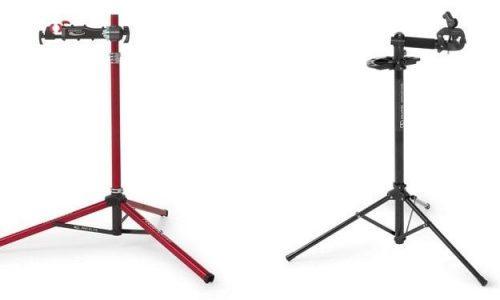Just pedals?
Pedals are a vital part of any cycle but in no other discipline do they make such a difference as road cycling where every extra gram and every missed clip could mean a missed podium or personal best.
The job of a pedal is to transfer the circular motion of the rider’s leg’s into the crank and therefore into the back wheel via the chain, but there is so much more going on. Efficiency can easily be lost in this area.
The pedal material can flex under the rider’s power causing wasted energy of varying degrees. Excess material will cause undue weight which must be carried by the rider and road cycling is a game of small increments so this tiny weight may tip the balance.
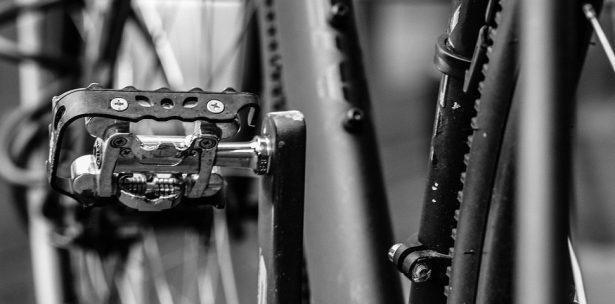
The power input by the rider at the pedal should be as efficiently transferred as possible as all wasted power results in a lower overall speed than the rider’s potential. The bike as a whole should not hamper potential but allow it to be realized.
A pedal should be simple to use and allow the rider to clip in with little fuss or missed attempts. The pedal should not release the foot unless this is what the rider wished. Too many times have we seen a Tour De France stage won or lost because a foot was pulled clear of the pedal.
Any wasted time due to a pedal being awkward or badly made is unacceptable in the eyes of the road cyclist. Pedals and cleats should also have a reasonable lifespan, road components are not cheap and value for money should always be considered when comparing products.
What do we want?
As with any product, we must first identify what the ideal product would be in order that we may know what areas to look at in each of the chosen products.
The “BEST” of any item is a subjective term so we aim to focus on the positive points of each pedal and leave the final evaluation down to the reader.
The areas we will cover for each pedal are functions that may be high on your list of priorities or maybe they sit lower.
This is a guide to help you purchase a product that best suits your needs and gives you the best product for your money. These are the sections we will consider.
Stiffness.
A well-constructed pedal with a tightly fitting cleat will offer more stability to the rider by allowing them to trust this interface.
The pedals can offer some lateral movement but must be solid vertically for maximum stiffness. Our bodies only interact directly with the bike in 3 places (Handlebar, saddle, and pedals) so feedback and feel is very important.
Weight.
As with all human-powered vehicles, the weight will always be a consideration. The competitive road cyclist wishes to transport themselves and the entire bicycle great distances and up steep inclines (where weight makes even more difference). Any weight saving will equate to some form of benefit, even if this may be immeasurable.
Efficiency.
The entire point of a pedal is to transfer the rider’s power into forwarding motion. The pedal must not flex under load as this will affect the efficiency of this transfer.
Pedal, cleat, and shoe all come under this heading so we will even look at the cleat mount bolts for more information.
Simplicity.
A road rider should be able to clip into their pedal in a fraction of a second without the need to think. The process should become second nature and feel as simple as gripping the handlebar with your hand.
A simple process to clip in and out will prevent wasted time searching for an elusive pedal and cause a smoother ride overall.
Longevity.
Road pedals are among the most expensive on the market and should offer a long life for the investment. A pedal that is easily serviceable gives the user the best chance of achieving this.
A pedal that comes with tools and is serviceable at home by anyone would be the gold star. A long-lasting pedal also offers high value for money.
Pedals, pedals, pedals.
Shimano PD-R8000 Review
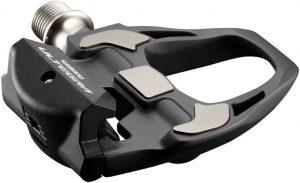
The first pedal on our list is the Shimano PD-R8000 Ultegra. These are available from REI.com or for $200 which is a lot of money for a pair of pedals but you could also splurge for the R9100 Dura-Ace models at $279.99 so these aren’t even top of the range.
The entry-level Shimao road pedal is just $52.99 and offers a solid start point. The Ultegra pedals weigh 248 grams and that puts them among the heaviest of the bunch. Using this cleat and pedal combination is extremely easy as the front of the pedal sits upward when not in use.
Judging where your cleat is on your shoe is not necessary as you simply slide your foot forward until it engages and then press down. The tension of these can be adjusted to your tastes which is a useful feature especially for those new to clipping in. These pedals are stiff!
The cleat is extra wide to spread your load as much as possible and the materials are top class. The carbon body adds stiffness over the lower (and cheaper) models so it is worth the extra cash if you can afford it.
Attaching and adjusting the cleat is a matter of just 3 bolts per shoe. These bolts have wide heads and large washers to add to the stiffness of the whole system.
The cleats are very high-quality plastic and are again very stiff to create an excellent clip system. These pedals are easily serviceable and have nice touches like the titanium inserts on the top of the pedal which stop the carbon from being damaged by repeated use.
Not a pedal for the ultra weight conscious but these score top in almost every other category. A solid choice for everyone who can afford the high price.
Shimano E600 SPD (Road touring) Review
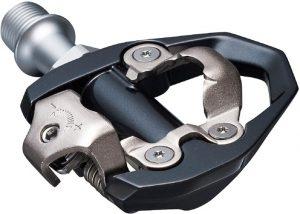
Sticking with Shimano, the E600 SPD Road Touring pedal is a completely different angle on pedals for the more casual road rider. They are available from www.rei.com and cost $100. This pedal is aimed at those who wish to still be able to walk in their cycling shoes.
These pedals use cleats that have the mounting method usually seen on mountain-bike or touring shoes so they will not fit road-specific shoes. ( always check before you buy)
The idea here is that instead of using a clunky mountain-bike pedal, (which many do) the pedal is slimmed down greatly to give better weight and function on the road. These only weigh 279 grams which for a road pedal is a lot, but for a mountain bike pedal is great.
Due to the heritage of the pedal, these are almost bombproof and will last likely for as long as the bike. They are adjustable, serviceable and use high-quality materials throughout.
Great for more casual road cyclists who want to be able to walk occasionally, the price is good but the downsides of this style are the reduced performance since this is nowhere near as stiff as a road pedal.
LOOK KEO Max 2 and Blade

One of the main competitors to Shimano in the road pedal market is Look, The KEO range of pedals have been around for a very long time and each version refines the design. The latest KEO 2 Max retails for less than $100 from Amazon.com.
The fancier big brother is the Look KEO Blade Carbon which sells for just a bit more and you can also find at Amazon.
The MAX 2 is listed at 260 grams which is very light for a pedal which costs less than half of a Shimano Ultegra pedal. The equivalent price Shimano pedal is 320 grams.
The KEO Blade pedal takes weight very seriously and weighs only 220 grams (or just 180 if you go for the titanium axle versions which cost more) and still costs less than the Shimano pedal offers.
The KEO Max pedals both use the same cleat which is smaller than the Shimano cleat and feels less stable in use. The build quality of both is much lower than the Shimano offer as well, with many parts being made of plastic rather than metal.
I have often seen two or three-year-old KEO pedals in need of replacement due to wear or play in the bearings(having not been serviced). The trick with these is to obtain the tool and complete the simple service procedure at home two or three times per year.
If you crash often then look elsewhere since the plastic body does not like tarmac. The Max 2 does have adjustable clip tension and is very easy to locate with your foot using the same method as Shimano.
These are the easiest pedals to clip into and out of in my experience so it may suit a less practiced rider or those with less confidence.
The KEO Blade is only adjustable via the slightly tricky mechanical procedure of replacing the whole carbon spring.
This comes in both 8nm and 12nm tensions which are quite tight so it’s not recommended for riding or repair beginners.
Overall these pedals offer excellent performance and low weight for the price but lack longevity. The KEO Max 2 is, however, my pedal of choice and I use them to this day.
Time XPRESSO Range
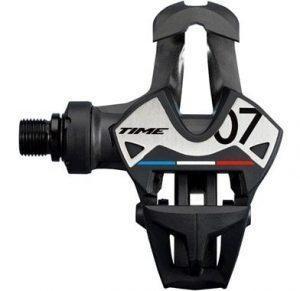
The pedals from Time are the underdogs of the group. These pedals are not found in many retailers so they may be completely new to you. They offer similar construction to the Look Keo with many plastic components and steel or titanium axles.
The XPRESSO 7 is the middle of the Time range which runs from $50 to $400. The XPRESSO 7 costs $125 and is available from Amaincycling.com. It offers a good amount of features for the price if you wish to stay away from the common choice of Shimano or Look.
The XPRESSO 7 is similar to the KEO Blade (and similarly priced) with its carbon spring technology, they offer a super-low weight of just 199 grams for the pair.
This is certainly the best weight vs price you will find as any pedal under 200 grams is considered extremely lightweight. Amazingly, the top of the range pedal from Time weighs just 133 grams but comes at the sky-high price of $400.
The XPRESSO 7 offers a stiff pedaling platform but feels slightly more flexible than the Shimano pedals, this is offset by the weight and is personal preference more than anything measurable.
The cleat on the Time is narrower than the other pedals and this may have something to do with the flexible feel also as the weight is less widely spread over the pedal body.
Clipping in on the Time pedal is not as simple as the other brands (with Look being the best) so these should only be attempted by veterans of the clipping game.
In terms of longevity, these are the worst on the test as the fragile body is easily damaged in the slightest accident. Under normal use, you should expect a few years from the pedal if serviced regularly.
Consider these if you have a retailer locally as servicing requires specific tools not available in a standard bike shop. Best for you weight weenies out there.
Bontrager Comp road Review
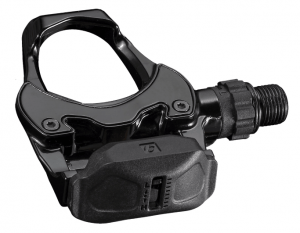
Bontrager is TREK’s in house component brand and offers the Comp road pedal for just $79.99 on its site Trekbikes.com. The pedal uses a LOOK KEO cleat so spares can be found easily.
The pedal is made from aluminum which adds to the weight but also makes these a good choice for a beginner who may take a few tumbles in the beginning. Servicing these is a simple affair and they use the Shimano tool which is found in most bike shops around the world.
They offer the same adjustable cleat tension as the rest and the cleats are easily fitted and adjusted. The Bontrager comp road pedal doesn’t offer anything new and the weight is similar to other (Shimano) similarly priced pedals.
That being said, these pedals will do everything asked of them and take a bit of a beating too.
The Bontrager pedal has the benefit of being among the easiest pedal to clip into and also benefit from the LOOK KEO cleats which offer differing release modes to suit everyone.
A beginner or road commuter could do a lot worse for this price so these are a solid choice especially if you can find them reduced.
The comp road pedal is a mix of Shimano and Look taking some of the best features and reducing the price to come up with a solid entry to clipping in.
The final choice of which pedal is best for you lies only with you. All of the above are high-quality items from reputable manufacturers. Do not buy pedals form an unknown brand since they could be a safety concern.
Consider your riding style and what you wish the pedal to accel at before making your decision. Any of the above pedals will work but choosing the one which offers the marginal gains you are looking for will make for a more enjoyable journey.
Always make sure to have your cleats properly adjusted before using the pedals as failure to do so can cause serious long term damage in the knees, ankles, and hips.

If you already suffer from any issues in these areas such as leg length discrepancies then perhaps consider the only pedal to offer ultimate adjustability and take a look into the Speedplay brand as this can sometimes alleviate your problems when fitted by a specialist.
You can find them on Amazon here but I highly suggest visiting your local professional bike fitter if you feel that these are necessary as setup is extremely difficult.
As a last note, pedals are specific to the left and right of your bike so thread them carefully into the correct side and remember to always grease the threads.

My name is David Mckinven AKA Wheels of Karma. Bikes have been my life and have taken me to rural Africa as a bike mechanic teacher, Dubai as the SBC workshop manager and to work for as long as I care to remember.
I have written for Cyclist magazine and a host of online publications. I truly believe that bikes can save our planet and that small changes will make all the difference.


